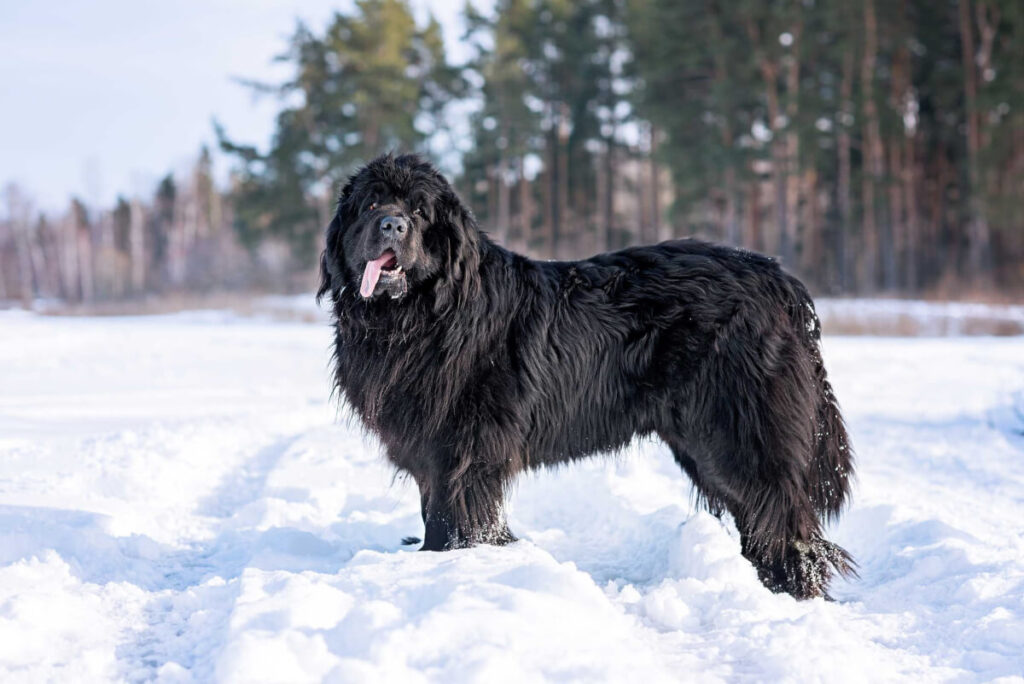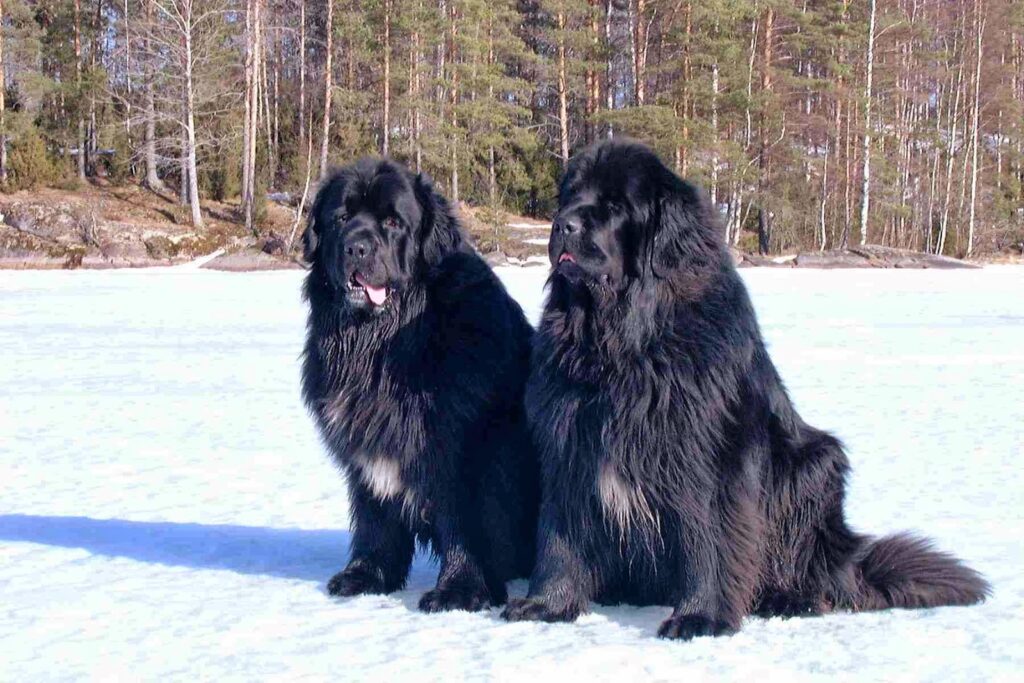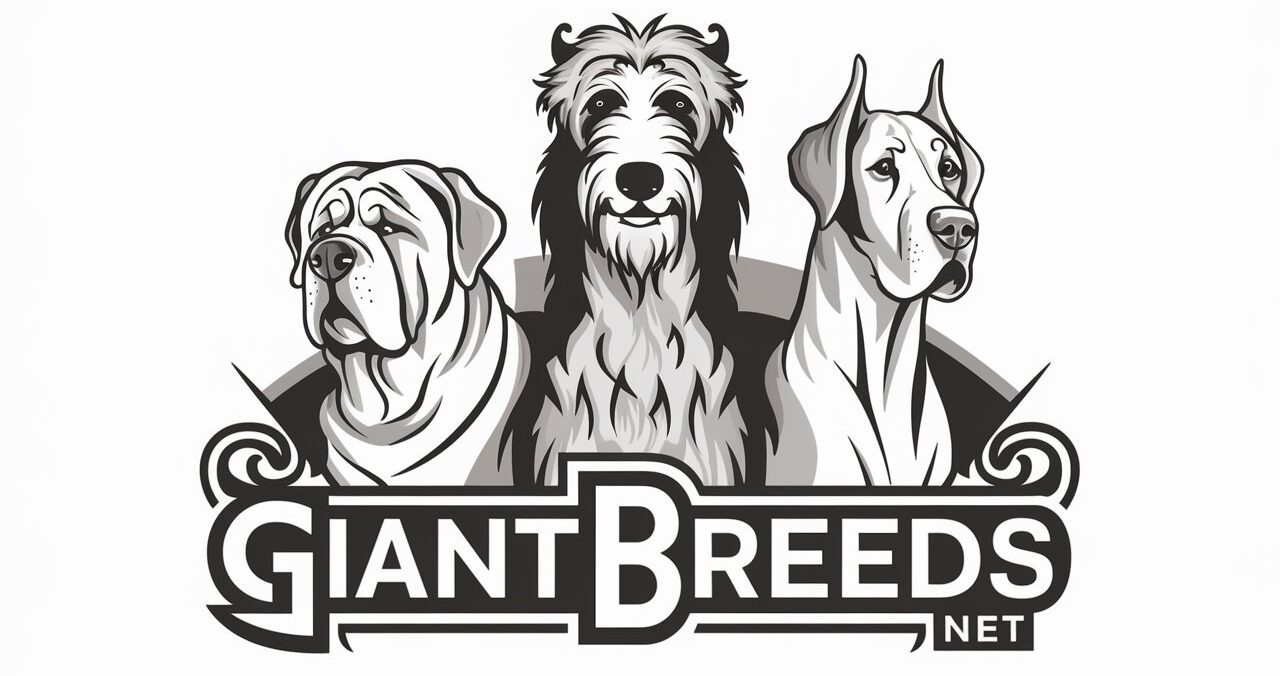

Characteristics of the Newfoundland
The Majestic Newfoundland: A Gentle Giant Among Dogs
Newfoundland’s, affectionately known as “Newfies,” are a unique blend of grandeur, strength, and tenderness. These gentle giants capture hearts with their serene disposition and unwavering loyalty. Let’s dive into the characteristics that make Newfoundland’s cherished companions and remarkable working dogs.
Impressive Size and Presence
Newfoundlands are a giant breed, with males typically weighing between 130 to 150 pounds and standing over 28 inches tall at the shoulder. Their imposing size reflects their historical role as hardworking dogs, capable of tackling challenging tasks in tough environments.
A Heartwarming Temperament
Despite their size, Newfoundland’s are the epitome of gentleness. Their sweet, patient nature makes them ideal family pets, earning them the nickname “gentle giants.” They form strong emotional bonds with their owners and are incredibly affectionate.
The Functional Beauty of a Water-Resistant Coat
Newfoundland’s boast a striking double coat that comes in various colors, including black, brown, gray, and the distinctive Landseer pattern. This water-resistant coat harks back to their days as water rescue dogs, enabling them to perform lifesaving duties efficiently.
Legendary Strength and Swimming Prowess
Newfoundlands are renowned for their strength and webbed feet, making them natural swimmers. Their history includes braving the cold waters of the North Atlantic, and their swimming skills are still celebrated today.
Balanced Exercise Needs
While not the most active breed, Newfoundland’s requires regular exercise to stay healthy and happy. Moderate daily activities help maintain their muscular build and keep their minds engaged.
Additional Traits That Endear Newfoundland’s
Beyond their physical traits, Newfoundland’s are known for their intelligence and trainability. They respond well to gentle guidance and have a calm demeanor, making them excellent therapy dogs. Their protective instinct makes them natural guardians, but their discerning temperament ensures they do not overreact.
Conclusion
The Newfoundland breed commands respect and admiration with their blend of physical might and emotional sensitivity. They are perfect for those seeking a pet that is both a protector and a loving family member. Whether as noble working dogs or compassionate companions, Newfoundland’s continue to capture the hearts of dog lovers worldwide.
If you’re considering a Newfoundland as a pet, it’s crucial to appreciate the full spectrum of their characteristics. These gentle giants are not just pets; they are lifelong friends who will leave an indelible mark on your heart.
The Newfoundland’s Legacy as Water Rescue Dogs
The Newfoundland dog, celebrated for its strength, loyalty, and gentle nature, has an impressive history as a top-notch water rescue dog. These maritime heroes are renowned for their love of water and lifesaving instincts, which have been documented throughout history.
A Rich Maritime Heritage
Hailing from the rugged coastlines of Newfoundland, these dogs were bred to assist fishermen and sailors. Their powerful build and swimming prowess made them invaluable for pulling nets, hauling fish carts, and rescuing individuals from dangerous waters. Their instinct to protect and rescue showcases their crucial role alongside seafarers.
Heroic Rescues and Loyal Companions
Newfoundland dogs are famous for their heroic rescues. They have braved icy seas and perilous conditions to save stranded boaters and fishermen. Their courage and determination in the face of adversity have cemented their place in maritime history. A notable example is Lord Byron’s Newfoundland, Boatswain, who was so cherished that his monument is larger than Byron’s own. This celebrates the breed’s virtues of beauty without vanity, strength without insolence, and courage without ferocity.

🛠️ Skill Track Compatibility
Training for Modern-Day Rescues
Why These Tracks Are Listed:
Every giant breed has strengths shaped by instinct, structure, and temperament. The Skill Tracks listed here highlight areas where this breed is most likely to thrive—not just in training, but in purpose. These aren’t requirements or limitations. They’re opportunities. When matched well, Skill Tracks bring out the best in both dog and human—offering focus, fulfillment, and a deeper working bond.
Newfoundland is good at Water because they were bred for it—complete with webbed feet, powerful swimming ability, and a natural affinity for the element. They excel when tasks are water-based.
Newfoundland is good at Rescue Work because of their strength, calmness, and natural instincts to help. In water or on land, they gravitate toward aiding the vulnerable.
Newfoundland is good at Therapy because their warmth, gentleness, and patience make them comforting companions. Their big presence provides both emotional and physical grounding.
Newfoundland is good at Social Work because they tolerate crowds and varied settings without stress. They’re approachable, friendly, and unshaken by public noise.
Today, Newfoundland’s continue to be trained as water rescue dogs. Programs like the Italian School of Water Rescue Dogs start training from puppyhood. After a year of rigorous training, these Newfies are ready for active service in water rescue operations, showcasing their enduring legacy and adaptability to modern needs.
The Newfoundland in Action
Newfoundland’s have unique physical attributes like a water-resistant double coat, a muscular tail used as a rudder, and webbed feet, making them efficient swimmers. Unlike the typical “doggie paddle,” they use a distinctive stroke, sweeping their paws to the side for maximum propulsion in the water.
A Symbol of Lifesaving Bravery
In the 18th and 19th centuries, few ships set sail without a Newfoundland on board. These dogs were always ready to leap into action, swimming to carry lines to land if the sea was too rough for boats. Their reputation for heroic water rescues is unmatched, and they remain a symbol of lifesaving bravery and dedication.
Conclusion The Newfoundland’s history as water rescue dogs is filled with acts of bravery, loyalty, and a spirit of service. These gentle giants have served as steadfast companions and guardians of human life. Their legacy continues to inspire, reminding us of the profound bond between humans and dogs, especially in the face of danger. The Newfoundland breed, with its remarkable water rescue heritage, stands as a proud testament to the extraordinary capabilities and heart of working dogs.
Why Newfies Make Great Pets
Newfoundland’s, or “Newfies,” are gentle giants with hearts as big as their massive stature. Loved by families and individuals alike, here’s why Newfies make fantastic pets and a wonderful addition to any home.
Sweet and Docile Temperament
Newfoundlands are known for their sweet nature and calm demeanor. Despite their size, they are incredibly gentle and patient, especially with children. The American Kennel Club praises their temperament, making them ideal companions for families.

Natural Protectors
Newfies have a natural protective instinct. They position themselves between their family and any perceived threat, showing their loyalty and courage. This protective nature is characterized by a dignified watchfulness rather than aggression, ensuring the safety of their loved ones.
Exceptional Swimmers
With a rich history as water rescue dogs, Newfies are incredible swimmers. Their webbed feet and water-resistant coat make them natural in the water. They love taking dips in lakes or pools and have a remarkable instinct for water rescue.
Intelligent and Trainable
Newfoundlands are intelligent and responsive to training. They might have an independent streak, but they excel with patient, respectful training methods. Using praise and food rewards works wonders with this breed, making training a rewarding experience for both.
Low Exercise Needs
Despite their large size, adult Newfoundland’s don’t require excessive exercise. Daily walks and occasional swims are enough to keep them healthy and happy. This makes them suitable for families or individuals who might not have the time for high-energy breeds.
Lifelong Friends
Newfoundlands are incredibly sociable and thrive on companionship. They form strong bonds with their owners and are known for their good-natured demeanor. They don’t do well when left alone for long periods, so they’re best suited for homes where they can enjoy constant company.
Grooming and Care
Their thick, heavy coat requires regular grooming to keep them healthy and comfortable. Brushing a few times a week and regular nail trims will keep a Newfie looking their best. While they do shed and can drool, the joy of having such a majestic creature by your side more than compensates for the grooming efforts.
A Historical Companion
Newfoundland’s have a rich history, originating from the island of Newfoundland. Bred to help fishermen, their robust build and stamina make them capable working dogs. Their historical role is reflected in their strong, enduring nature.
Conclusion
Newfoundlands are a perfect blend of strength, sweetness, and loyalty. They fit seamlessly into family life with their protective instincts and love for water. If you’re looking for a pet that’s more than just a companion, a Newfoundland is an excellent choice. They offer unconditional love and joy, enriching lives in immeasurable ways.
Are you ready to welcome a Newfoundland into your home? They’re waiting to offer you a lifetime of loyalty, affection, and memorable moments.
References:
1. Hill’s Pet, Newfoundland Dog Breed – Facts and Traits.
2. Your Purebred Puppy, Newfoundland’s: What’s Good About ‘Em, What’s Bad About ‘Em.
3. Dogs Best Life, Newfoundland: Gentle giant, protective instincts, good with kids.
What Owners Need to Keep Them Engaged

How to Keep Your Newfie Happy and Healthy
Newfoundlands, or “Newfies,” are gentle giants with specific needs to stay happy and healthy. Here’s a simple guide to keeping your Newfie engaged and in top health.
Exercise and Swimming Newfies love to swim! Their webbed feet and water-resistant coat make them natural swimmers. Regular swimming sessions give them the exercise they need and keep their joints healthy. On land, they enjoy hikes and long walks. Exercise is essential for their physical and mental well-being.
Socialization Start socializing your Newfie early. Introduce them to different people, pets, and environments. Dog parks, pet-friendly events, and obedience classes are great for socialization. A well-socialized Newfie is more confident and less prone to anxiety or aggression.
Training Training your Newfie is rewarding due to their intelligence and eagerness to please. Use positive reinforcement like treats and praise. Consistent training helps them develop social skills and manage their size and strength at home.
Space Newfies need space to stretch and roam. A house with a large, fenced yard is ideal. Indoors, they need room to move without feeling confined. Cramped spaces can stress them out, leading to destructive behavior or health issues.
Health Care Regular vet check-ups are crucial. Newfies are prone to genetic conditions like hip and elbow dysplasia, heart disorders, and ear infections. Early detection and management of these conditions are key. Talk to your vet about regular screenings and preventive care.
Nutrition A balanced diet tailored to their size, age, and activity level is essential. Overfeeding can lead to obesity, which strains their joints. Consult your vet to create a nutrition plan and consider supplements if needed.
Additional Considerations
- Grooming: Regular brushing is needed to prevent matting and manage shedding.
- Weather Sensitivity: Newfies can overheat in hot weather. Ensure they have shade and water.
- Mental Stimulation: They thrive on mental challenges. Puzzle toys and training games keep their minds sharp.
By focusing on these key areas, you’ll provide a nurturing environment for your Newfie. Tailor these guidelines to your pet’s unique personality and needs. With the right care, your Newfoundland will be a joyful and loving member of your family for years to come.
The Challenges of Owning a Newfoundland Dog

Newfoundlands are gentle giants with a loving nature and impressive water rescue skills. While they capture many hearts, owning a Newfoundland comes with its own set of challenges. Here’s what you need to know before bringing one into your home.
Size and Space Newfoundlands are huge! They need plenty of room to move around and stretch their legs. Compact living spaces without a sizable yard aren’t ideal for them. If you don’t have ample space, a smaller breed might be a better fit.
Grooming Needs Their voluminous coats are stunning but require regular grooming to prevent tangles and mats. Routine brushing is essential to keep them looking their best. Be prepared for a bit of shedding too.
Exercise Requirements Despite their calm demeanor, Newfoundlands need daily exercise to stay healthy and happy. Without enough physical activity, they can become overweight, leading to various health issues. Daily walks and playtime are a must.
Drooling Newfoundlands are known for their drooling, especially after eating or drinking. This can be a bit messy, so if you prefer a spotless home, you’ll need to get used to cleaning up drool.
Socialization Early socialization is crucial for Newfoundlands. Introduce them to different people, pets, and environments to ensure they grow up to be well-behaved and comfortable in various settings.
Training a Newfoundland requires patience and consistency. They are intelligent and eager to learn but have an independent streak. A firm yet gentle approach works best for this breed.
Health Concerns Newfoundlands are prone to certain health conditions like joint dysplasia and heart issues. Regular vet check-ups are important and be prepared for potential veterinary expenses.
Lifespan Newfoundlands typically have a shorter lifespan than smaller breeds, often living between 8 to 10 years. This can be tough for owners who form deep bonds with their pets.
Conclusion While Newfoundlands make loyal and loving companions, they come with specific requirements that demand time, space, and emotional investment. Prospective owners need to weigh these considerations to ensure they can provide the best life for these gentle giants.
By understanding these drawbacks and being prepared, you can make an informed decision about whether a Newfoundland is the right pet for you. Their love and loyalty make the extra effort worthwhile for many dog lovers.

Common Health Issues in Newfoundland’s
Newfoundland’s, affectionately known as “Newfies,” are the gentle giants of the dog world. Their calm demeanor and loving nature make them wonderful family pets and loyal companions. However, like all breeds, Newfies have some specific health concerns that owners should be aware of.
Newfies are prone to hip and elbow dysplasia, common in larger breeds. These hereditary conditions result from improper joint development, leading to arthritis and discomfort. Genetics play a significant role, but diet and exercise can also influence the development and management of these issues.
Bloat (Gastric Dilatation-Volvulus)
Bloat, or GDV, is a serious and potentially fatal condition affecting large breeds like Newfoundland’s. It involves a rapid buildup of gas in the stomach, causing it to twist and cut off blood flow. Immediate veterinary attention is crucial to treat this condition.
Osteosarcoma, a type of bone cancer, can affect large breeds. Symptoms include lameness, pain, and swelling. Early detection is key to managing this aggressive cancer.
Eye Conditions
Newfies can suffer from entropion, where the eyelid rolls inward, causing discomfort and potential corneal damage. Surgical correction is often required to prevent long-term vision problems.
Young Newfies may experience panosteitis, often called “growing pains.” This condition affects the long bones during growth spurts, causing temporary lameness and pain. It typically resolves as the dog matures.
Luxating Patella
Luxating patella is a condition where the kneecap dislocates from its normal position. Severity can vary from minor inconvenience to needing surgical intervention.
Patent Ductus Arteriosus (PDA)
PDA is a congenital heart defect that can occur in Newfoundland’s. It involves a blood vessel that remains open after birth, which can lead to heart failure if not corrected.

Managing These Health Issues
While this list of health concerns may seem overwhelming, many Newfies live long and healthy lives with proper care. Regular veterinary check-ups, a balanced diet, and appropriate exercise are crucial. Genetic screening can also help manage and prevent some of these conditions.
Being informed and proactive about your Newfie’s health will help ensure you both enjoy many happy years together. Remember, every dog is unique, and not all will experience these health issues. Awareness is the first step toward prevention and early intervention.
By providing your Newfie with the love and care they need, you can help them live a long, happy, and healthy life.

